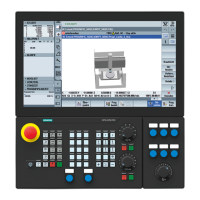Axis couplings
9.2 Curve tables (CTAB)
Job planning
518 Programming Manual, 07/2010, 6FC5398-2BP40-0BA0
Approximate value for CTABINV
The
CTABINV command, therefore, requires an approximate value for the expected master
value.
CTABINV returns the master value that is closest to the approximate value. The
approximate value can be, for example, the master value from the previous interpolation
cycle.
Incline of the curve table function
The output of the incline (
<gradient>) makes it possible to calculate the velocity of the
leading or following axis at the corresponding position.
Specification of the leading or following axis
The optional specification of the leading and/or following axis is important if the leading and
following axes are configured in different length units.
CTABSSV, CTABSEV
The
CTABSSV and CTABSEV commands are not suitable to query programmed segments in the
following cases:
● Circles or involutes are programmed.
● Chamfer or rounding with
CHF/ RND is active
● Smoothing with
G643 is active
● NC block compression with
COMPON/COMPCURV/COMPCAD is active
9.2.7 Curve tables: Check use of resources (CTABNO, CTABNOMEM, CTABFNO,
CTABSEGID, CTABSEG, CTABFSEG, CTABMSEG, CTABPOLID, CTABPOL,
CTABFPOL, CTABMPOL)
Function
The programmer can use these commands to obtain up-to-date information about the use of
resources for curve tables, table segments, and polynomials.
Syntax
CTABNO
CTABNOMEM(<memory location>)
CTABFNO(<memory location>)
CTABSEGID(<n>,<memory location>)
CTABSEG(<memory location>,<segment type>)
CTABFSEG(<memory location>,<segment type>)
CTABMSEG(<memory location>,<segment type>)
CTABPOLID(<n>)
CTABPOL(<memory location>)
CTABFPOL(<memory location>)
CTABMPOL(<memory location>)

